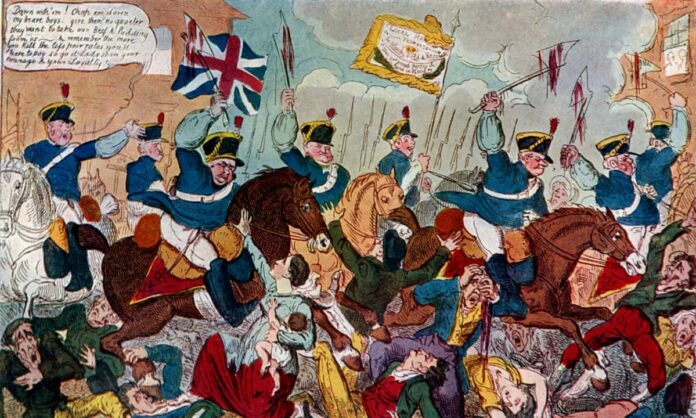A bloody outrage known as The Peterloo Massacre took place in what is now St Peter’s Square, Manchester, England on the 16th of August 1819. 60,000 peaceful pro-democracy and anti-poverty protesters were mercilessly cut down by 600 sword wielding mounted Hussars. 18 people were killed including four women and a child. They died from sabre cuts and trampling horse’s hooves. A further 700 men, women and children received extremely serious injuries. They had been demonstrating peacefully in the name of liberty and freedom from poverty. The Massacre occurred during a time of immense political unrest and mass protests. Fewer than 2% of British the population at that time had the vote. Poverty and hunger was rife with the disastrous corn laws making bread unaffordable. While dastardly ocurrances such as this are largely recorded and remembered in Ireland, they are conspicuously ignored in England. This is one of the exceptions.
The Red Cap of Liberty
On the morning of August 16th 1819 the crowd began to gather. They were conducting themselves with dignity and discipline. The majority were dressed in their Sunday best according to contemporary accounts.
The key speaker was the times famed orator Henry Hunt. The platform consisted of a simple cart, located in the front of what’s now the Manchester Central Conference Centre. The space was filled with banners – REFORM, UNIVERSAL SUFFRAGE, EQUAL REPRESENTATION and LOVE. Many of the banner poles were topped with the red cap of liberty – a powerful symbol at the time.
Local magistrates watching from a nearby window panicked at the sight of the assembly, and read the riot act ordering what little
of the crowd could hear them to disperse.
The Rampaging Massacre
600 Hussars, several hundred infantrymen; an artillery unit with two six-pounder guns, 400 men of the Cheshire cavalry and 400 special constables waited in reserve. The local Yeomanry were given the task of arresting the speakers. The Yeomanry, led by one Captain Hugh Birley and Major Thomas
Trafford, were a paramilitary force drawn from the ranks of the local mill and shop owners.
Hussars on horseback, armed with sabres and clubs, many with old scores to settle with the leading protesters. In one instance, spotting a reporter from the radical Manchester Observer, a Yeomanry officer called out “There’s Saxton, damn him, run him through.” They charged when the crowd linked arms to try and stop the arrests, and proceeded to strike down banners and people with
their swords. Rumours from the period have persistently stated the Yeomanry were drunk. The panic was interpreted as the crowd attacking the yeomanry, and the Hussars Led by Lieutenant Colonel Guy L’Estrange were ordered in.
A Few “Peterloo” Heroes
As with the Tiananmen Square Massacre, there were a few unlikely heroes among the military. An unnamed cavalry officer attempted to strike down the swords
of the rampant Yeomanry, crying – “For shame, gentlemen: what are you about? The people cannot get away!” But the majority joined in with the blood thirsty attack. The term ‘Peterloo‘, was intended to mock the soldiers who attacked unarmed civilians by echoing the term ‘Waterloo’, the soldiers from that battle being seen by many as heroes.
The Aftermath
The carnage was over at 2pm with the bloody field left full of dead bodies and abandoned banners. Journalists who were present at the event were arrested. Others who reported on the event were subsequently jailed. Businessman John Edward Taylor went on to help set up the Guardian newspaper as a reaction to what he’d seen. The speakers and organizers were put on trial under the charge of High treason – a charge reluctantly dropped later by the prosecution. The Hussars were cleared of any wrong-doing by the official inquiry and they and the Magistrates received a message of congratulations from the Prince Regent.
The Legacy
Historians acknowledge that “Peterloo” was hugely influential in ordinary people winning the right to vote, led to the rise of the Chartist Movement out of
which grew the Trade Unions. It also resulted in the establishment of the Manchester Guardian now the Guardian Newspaper.
Nick Mansfield, director of the People’s History Museum in Manchester says, “Peterloo is a critical event not only because of the number of people
killed and injured, but because ultimately it changed public opinion to influence the extension of the right to vote and give us the democracy we enjoy
today. It was critical to our freedoms.”
The poet Percy Shelley offers an angry portrayal of a nation torn by civil unrest and brutality: Shelley wrote the following poem shortly after the Peterloo Massacre. ‘England in 1819’ is one of Shelley’s most angry and politically direct poems presented here more than two centuries on.
England in 1819
An old, mad, blind, despised, and dying King;
Princes, the dregs of their dull race, who flow
Through public scorn,—mud from a muddy spring;
Rulers who neither see nor feel nor know,
But leechlike to their fainting country cling
Till they drop, blind in blood, without a blow.
A people starved and stabbed in th’ untilled field;
An army, whom liberticide and prey
Makes as a two-edged sword to all who wield;
Golden and sanguine laws which tempt and slay;
Religion Christless, Godless—a book sealed;
A senate, Time’s worst statute, unrepealed—
Are graves from which a glorious Phantom may
Burst, to illumine our tempestuous day.

